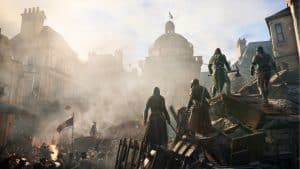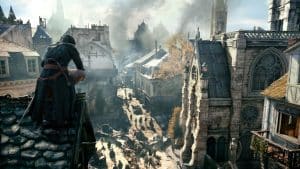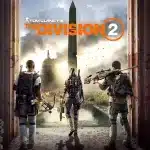Assassin’s Creed: Unity
Related Games
Description
🔥 What is Assassin’s Creed: Unity for PC
Assassin’s Creed: Unity is a historical action-adventure game developed by Ubisoft Montreal and released for PC in 2014. It takes players to revolutionary Paris during the late 18th century, immersing them in the chaos, ideals, and bloodshed of one of Europe’s most turbulent eras. You play as Arno Dorian, a young man drawn into the centuries-old conflict between Assassins and Templars, seeking redemption and answers after a personal tragedy.
Unity marked a shift for the franchise by introducing a completely redesigned parkour system, a more personal narrative, and a massive, detailed open world built around the life and architecture of Paris during the French Revolution. From Notre Dame to the bustling markets of Les Halles, every district tells its own story. The game’s single-player campaign intertwines with cooperative multiplayer missions, offering both an emotional journey and social gameplay rooted in historical drama.
At its heart, Unity is about the transformation of both a man and a city how ideals, betrayal, and love collide against the backdrop of revolution. Its dense crowd simulations, realistic interiors, and layered stealth mechanics make it one of the most ambitious entries in the series, even if its initial technical struggles overshadowed its bold design goals.
👉 Features of Assassin’s Creed: Unity
Revolutionary Paris Recreated
Unity’s biggest achievement is its extraordinary recreation of late 18th-century Paris. Thousands of NPCs fill the streets, riots erupt spontaneously, and landmarks are recreated with historical accuracy that borders on obsessive. Players can climb cathedrals, explore rooftops, and sneak through underground catacombs while hearing chants of revolution echoing from below.
This level of environmental storytelling creates a living, breathing city. Every alleyway hides stories of despair or defiance, and the sense of immersion is strengthened by period-accurate lighting, clothing, and architecture.
Refined Parkour and Movement System
The game introduced a completely rebuilt movement system that allows Arno to fluidly scale buildings, leap between rooftops, and descend with precision. Two dedicated buttons for climbing up and down added a new level of control to navigation, making movement feel deliberate rather than chaotic.
While previous entries sometimes made players fight against the controls, Unity’s system feels more natural, almost balletic, reflecting Arno’s agility and training. This made exploration not just a means to an end, but a satisfying experience in itself.
Deep Customization and Equipment
For the first time in the series, players could deeply customize their Assassin’s outfit, weapons, and gear to match their preferred playstyle. From stealth-oriented builds with silent weapons to heavy armor for combat-focused players, every choice affected performance and appearance.
Each piece of gear comes with distinct stats and bonuses, allowing experimentation with tactics. Whether you prefer to vanish into crowds or charge into battle, Unity gives you the tools to shape your approach.
Cooperative Multiplayer Missions
Unity introduced four-player cooperative missions that allowed friends to team up as Assassins and tackle complex objectives together. These missions blend stealth, strategy, and coordination, offering a unique layer of replayability that complements the main story.
Co-op tasks are not simple side content they’re elaborate, multi-stage challenges where teamwork truly matters. Each player can take on a role, from lookout to infiltrator, creating dynamic experiences with real tension and reward.
Improved Combat and Stealth Systems
Combat in Unity focuses more on timing, precision, and positioning than brute force. Parrying, counterattacking, and managing stamina matter more than in earlier titles. Stealth was also enhanced with cover mechanics, detection indicators, and silent assassinations that encourage patience and planning.
This combination pushes players to think before acting. Missions can often be approached in multiple ways, rewarding creativity and observation rather than mere reflex.
Gameplay
The Flow of Parisian Freedom
Assassin’s Creed: Unity centers around free exploration and mission-based progression within an open world full of side quests, collectibles, and dynamic events. The player can roam across Paris at will, climbing structures, tailing targets, and infiltrating restricted zones in search of clues or treasure.
Arno’s story missions often combine investigation, stealth, and combat in flexible order. The “black box” assassination design allows you to choose your path create distractions, sneak through secret entrances, or strike from above. This freedom gives every mission a sense of ownership and replay value.
Economy, Gear, and Progression
Unity’s progression system ties your growth directly to your actions and exploration. Completing missions and challenges grants money and skill points used to upgrade weapons and abilities. Paris also offers renovation projects restoring cafés and buildings that generate income over time.
The variety of weapon types, from rapiers to pistols and guillotines, changes how fights unfold. Each has different reach, speed, and impact, pushing you to experiment as the difficulty increases. Upgrading gear becomes not just about power, but about refining your identity as an Assassin.
Side Content and Co-op Integration
Beyond the main story, the game offers dozens of optional missions: murder mysteries, historical events, and secret treasure hunts tied to real figures from revolutionary France. Many of these activities reward you with rare items and lore that deepen the historical immersion.
Co-op missions expand the gameplay loop by encouraging coordination and strategy. Playing alongside others adds unpredictability sometimes exhilarating, sometimes chaotic but always fresh, turning Unity’s dense city into a shared playground of stealth and improvisation.
Graphics
A City Built on Detail
Assassin’s Creed: Unity remains one of the most visually ambitious titles in the franchise. Its depiction of Paris includes fully explorable interiors, dynamic lighting that reflects time and weather, and thousands of animated citizens performing daily routines. The sheer density of visual data makes the world feel alive even years after release.
Textures and architecture are designed with an eye for authenticity. Churches, palaces, and slums each have their own mood and level of grandeur, illustrating the social divide at the heart of the Revolution.
Lighting and Atmosphere
The lighting system plays a crucial role in setting tone soft candlelight glows through windows at night, smoke lingers over barricades, and sunlight filters through cathedral stained glass. These effects enhance not just realism but emotion, reinforcing the weight of the story and setting.
The art direction leans toward naturalistic tones punctuated by bursts of revolutionary color reds of flags, golds of royal halls, and the pale stone of Paris itself. Every visual cue supports the narrative of conflict and change.
Animation and Cinematic Presentation
Character animations in Unity are fluid and richly detailed, from subtle facial expressions to complex assassination sequences. Cutscenes transition seamlessly into gameplay, maintaining immersion and pacing. Crowd animations, though heavy on performance at launch, demonstrate Ubisoft’s ambition in simulating a living city.
Performance patches over time have improved stability, allowing players today to experience the full scope of Unity’s technical artistry without the original frustrations.
Pros and Cons
✔️ Pros
- Stunning recreation of Revolutionary Paris with unmatched architectural detail
- Refined parkour and movement mechanics offering freedom and precision
- Deep gear customization that supports varied playstyles
- Cooperative multiplayer missions with real strategic depth
- Atmospheric storytelling with emotional stakes and historical immersion
❌ Cons
- Initial release was plagued by technical issues and performance drops
- Combat can feel slower compared to later entries
- Some repetitive mission structures in side content
- Limited freedom in dialogue and moral choices
ℹ️ Game information
Release Date: 13/11/2014
Update Date: 10/11/2025
Version: v1.5.0
Genre: Action
Platform: PC
Language: ![]()
![]()
![]()
![]()
![]()
![]()
![]()
![]()
Weight: 50 GB
Additional info: New version includes all DLCs to date
⭐ Installation Instructions
- The game is fully complete, you just need to install it, so there is no need to unpack it or download it from other sources.
- Just run the Assassin’s Creed: Unity.exe installation file.
- Simply launch the game from shortcut desktop.
⚙️ System Requirements
✅ Minimum:
- OS: Windows 10 64-bit
- Processor: Intel Core i5-2500K @ 3.3 GHz / AMD FX-8350 @ 4.0 GHz
- Memory: 6 GB RAM
- Graphics: NVIDIA GeForce GTX 680 / AMD Radeon HD 7970 (2 GB VRAM)
- DirectX: Version 9.0
- Network: Broadband Internet connection
- Storage: 50 GB available space
✅ Recommended:
- OS: Windows 10 64-bit
- Processor: Intel Core i7-3770 @ 3.4 GHz / AMD FX-8350 @ 4.0 GHz
- Memory: 8 GB RAM
- Graphics: NVIDIA GeForce GTX 780 / AMD Radeon R9 290X (3 GB VRAM)
- DirectX: Version 9.0c
- Network: Broadband Internet connection
- Storage: 50 GB available space
Images










